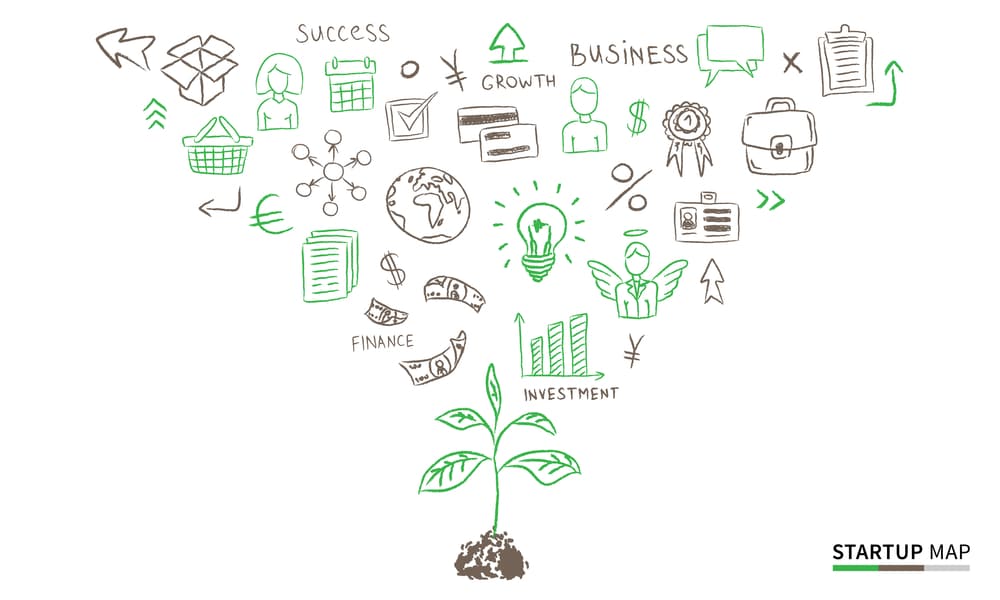7 Things You Need to Know About Y Combinator and Seed Stage Startup Funding

We’ve all heard the stories of companies like Microsoft and Amazon starting in Bill Gates’ parents’ garage and Bezos’ small office and then growing into multi-billion-dollar corporations that are household names and have impacted the world. We know the story, but realistically, how does a company get from being a vague idea to a world changing enterprise?
Today’s topic is about that all-important step, Funding! We’ll be particularly focusing on seed-stage funding and how Y Combinator can put your start-up on the map.
Let’s get down to business.
The Basics
The concept of seed stage funding is pretty simple. Once a startup is created its immediate goals are to solidify its business plan, develop its product, and grow baby grow. But all of this requires money! How much money, will depend on the goals of your business.
If your startup is a small non-profit app meant to help dogs at your local county shelter you’ll need less funding than a startup that wants to become a global household name and knock Amazon off the map.
Regardless, you’re going to need help with funding in order to create the product, improve it, and then hire enough people to help you develop, market, and sell it.
For you Future Founders out there- let’s jump right into the details of Seed Stage Funding and how Y Combinator can help you get there.
1 – WHAT IS SEED STAGE FUNDING?
So, in the most basic terms, seed stage funding is the best way for a business to take its first steps and put it past the concept phase. An injection of funds is what’s needed to get it off the ground, and comes by way of what money you’ve saved, a bank loan, funds borrowed from friends and family, crowdfunding, that sort of thing. Keep in mind there is no such thing as free money, so no matter who invests into your start-up, one thing is for sure – they’ll want something in return whether it’s interest on a loan, part ownership, stock options, whatever.
2 – WHAT IS SEED STAGE FUNDING USED FOR?
The function of seed stage investment is usually to progress the research and development phase far enough to reach a point where the product or service offered can be introduced to the market. Without this little nest egg, a start-up will struggle to achieve the quality in what they’re selling as it will be lacking the free cash to pay for that preliminary refinement process.
3 – THE PHASES OF STARTUP FUNDING:
SEED STAGE:
We’ve already covered this one as the earliest and arguably most important step to helping a start-up company go from lofty ambition to actual realization. This generally involves $3m of fundraising after an initial startup valuation of between $3-6m to launch the product, then build traction until the revenue is at an acceptable level, recruit additional team members, and prepare the product for its 1st major release.
SERIES A FUNDING:
This is the first round of venture capital financing for a startup company. It’s at this point that an accelerator would be approached for interest in the budding business, as work needs to be done developing a more expansive business model, to ensure that the right people are in key personnel roles for the coming growth, to determine a scalable market blueprint, and finally to further the development of the product or service being offered.
By this time there would be a sizeable customer base, but this is the crunch time, a period where the CEO begins to really understand how fundraising works and why it’s needed in order to reach that next level as a company. In a company valued at $15-30m, they’d need somewhere in the vicinity of $15m worth of injected funds in order to both stay afloat and grow at the same time.
SERIES B FUNDING:
Once the startup starts to mature in terms of customers from their target market, and needs to scale up further, a subsequent round of series B venture capital funding needs to be looked at. A steady stream of revenue is great, but it won’t be enough to fuel expansion into other markets, and other demographics, or to add to the line of products or lists of offered services.
It’s at this stage that a startup also has to consider the competition, and how to assure market dominance in what is surely an already fiercely competitive and niche market. If the startup is valued at $30-60m, it will require roughly $30m as a revenue boost to compete in the market with a higher quality product, as well as outlive competitors.
SERIES C FUNDING:
Series C venture capital funding is often the last round of funding for many startups. Although some proceed on to series D and even E funding occasionally, by Series C they are frequently valued at millions of dollars and have achieved a significant level of success. Startups that proceed to series C funding typically need additional time to hit certain growth goals before taking the next step or are planning a merger or acquisition of another company.
For example, if a company has already gone through Series B funding and was given $30 million dollars they may decide to proceed to series C if they have large goals such as spreading into international markets. With a goal like this it may be smarter to acquire or merge with a competitor that is already present in the market you are attempting to break into. Taking on the task of merging with a foreign company is definitely a valid reason to go through a series C round of funding.
There’s really no shortage of investors at this stage, as the startup has now proven itself in the market. It’s more likely to see hedge funds, banks, and venture capital companies become involved as investors at this stage. During the series C funding round they typically value a startup at $100-120m.
SERIES D FUNDING:
While many companies can achieve their goals with Series C funding, some decide to go for Series D Funding. This round of funding is a special round that can help a startup that is still struggling to reach its growth goals or is experiencing a special situation such as a merger with another company or acquiring a competitor in which additional time and funds are needed. While these reasons are similar to Series C there is an additional reason a startup may move on to Series D funding.
A startup could also seek Series D funding to further increase its valuation before going public. Many startups have an exit strategy of either growing the company until they can take it public or selling it to a larger competitor. An example of this would be Instagram which started in 2010 with seed funding of $500,000 and then the founders sold the company to Facebook 2 years later in 2012 for $1 Billion dollars. They could have decided instead of selling to Facebook to take the company public and remained founders and CEOs for Instagram, but their exit strategy was to sell. $1 Billion dollars in 2 years isn’t a bad deal!
Typically, at this stage of investment, a company is relying upon investments from late-stage VCs, Private Equity Funds, or hedge funds. Series C and D investors include companies like Sequoia Capital and Lightspeed Venture Partners. This round of funding can raise an additional $100m and companies are typically valued at $150-$300m.
IPO/STOCK MARKET LAUNCH:
The Initial Public Offering or IPO may not be the ultimate goal for all startups but going public is definitely the choice to make if you want to further expand the business. Keep in mind that all the investors who have thrown cash into the start-up at this point will make their money back and then some, post IPO. They may choose to sell their stock to make the quick buck, or to retain it if they see solid growth potential for the future.
Being listed on the NASDAQ exchange is the graduation from start-up to fully fledged company. But first, you’d expect to see somewhere in the vicinity of $100m in gross revenue as a rough measure of whether the startup is ready for an IPO.
4 – WHERE DOES Y COMBINATOR FIT IN?
For more than 15 years, Y Combinator has been the seed money start-up accelerator that has made success possible for a whole bunch of companies to reach their full potential – more on that later.
They interview and select 2 batches of companies per year in 3-month cycles – January through to March, and June through to August. It’s an intense screening process where the product or service being offered, the business model, future plans, and everything in between are discussed with the start-up company applying.
Once successful, a start-up company will receive seed stage funding, professional advice, and more importantly connections within the business world – in exchange for a 7% stake in the start-up company.
The professional advice aspect is run during office hours, where the start-up founders have meetings with Y Combinator staff as well as group sessions with other entrepreneurs. The goal isn’t to just hand out seed stage funding, but to help startups with accurately assessing their fundraising potential, and whether it will be enough to sustain growth or stall progress – as well as other important business fundamentals.
It’s the connections that are made through Y-Combinator, however, that are the most attractive beneficial side effect of having them seed a start-up. Weekly dinners are held where titans of industry, in particular the Big 4 down in Silicon Valley, are asked to be guest speakers to share pearls of wisdom.
Each cycle culminates in Demo Day, where the startups have the opportunity to present their ideas to an audience made up of many of the world’s foremost start-up investors – giving them the opportunity to land the angel investor of a lifetime.
5 – Y COMBINATOR PROS
GOING ALL IN
If you’re dedicated to your start-up business, then you must dedicate yourself solely to its success, to give it every chance to pick up steam. A short term, intense, and hugely immersive experience like being seeded by Y Combinator could be the catalyst that takes your start-up to the next level.
RUBBING THE RIGHT SHOULDERS
If you’re an aspiring entrepreneur, odds are that you don’t have a little black book chock a block full of the names and phone numbers of some real power players in your industry. Y Combinator is the icebreaker between your start-up and investors, thanks to programs like the weekly dinner seminars, and Demo Day.
KNOWLEDGE IS POWER:
There’s an opportunity to learn more in 3 months with Y Combinator, than in 3 years as a struggling start-up company. It’s a bit like college, with seminars and lectures you attend, but at the same time different in the sense that a lot of the learning is peer driven, where startups are both advised by other startups, and at the same time, give their own advice to them.
6 – Y COMBINATOR CONS
LIFE GETS IN THE WAY
Not everyone is in the financial position to just put their life on hold for 3 months. The concept of moving to a different city short term, of effectively attending a crazily intensive business school for 3 months, may be a little too much for entrepreneurs to commit to when they have a family, or need to work a job to keep the bills paid.
NOT A GREAT FIT
While Y Combinator is an awesome opportunity for start-up companies, it’s not for everyone. There are a few exceptions where the concept or idea for the start-up isn’t compatible with the business guidelines that Y Combinator hopes to teach. If your start-up theme isn’t seen to fit in with the group, then it’s entirely likely you won’t make it past the selection and interview process.
YOU WANT IT ALL
Some startups don’t see the benefit versus the cost and want to retain all their equity instead of giving an accelerator program a slice of the pie.
7 – WHO’S USING Y COMBINATOR?
Y-Combinator has helped many companies reach their full potential, with 125 worth more than $150m and a combined alumni value exceeding $300b! AirBnb, DoorDash, Stripe, Cruise, Dropbox, Coinbase, Reddit and Gitlab are just a few companies who used Y-combinator as the accelerator and seed money source they needed to really take off.
BONUS: WHAT OTHER ACCELERATORS ARE OUT THERE?
It’s important to note that Y-Combinator isn’t the only game in town – even if they’re one of the biggest. Though Y Combinator is undoubtedly the best accelerator, and has an exemplary track record of 21 unicorns (that is, companies worth more than a billion dollars), there are a few alternatives:
500 Startups:
With an impressive 19 unicorns on their roster, 500 Startups are nothing to sneeze at either with a total of 85 startups valued at more than $100m. They have the benefit of being partnered with the United Arab Emirates based SHUAA Capital, who have committed an investment capital of $600m to the accelerator.
Techstars:
Making an outstanding 2,200 total investments in startups, Techstars are one of the world’s leading accelerators. They have the advantage of having the best investment to exit ratios, hinting at the fact that they have a keen eye and only front capital for worthwhile causes.
AngelPad:
Up until 2018, AngelPad shared first place with Y Combinator in terms of effectiveness, according to the MIT & Brown University Seed Accelerator rankings. Though they’ve now been overtaken in raw numbers, their bootcamps are legendary and focus more on the education and teaching side of things as opposed to making connections like other big accelerators.
Next Steps
If you enjoyed this blog then check out our blogs on How To Hire Your First Engineer as a Startup Founder and The Best Way to Tell if an Engineer Will Fit Your Startup Culture.
Kofi Group is proud to be a source of knowledge and insight into the startup software engineering world and offers a multitude of resources to help you learn more, improve your career, and help startups hire the best talent. If you are interested in learning more about what we do and how we can help you then get in touch or watch our Youtube videos for additional information.
Share This Blog
Kofi Group has helped 100+ startups hire software and machine learning engineers. Will fill most of the roles we recruit on with 5 or less candidates presented.
Contact us today to start building your dream team!


